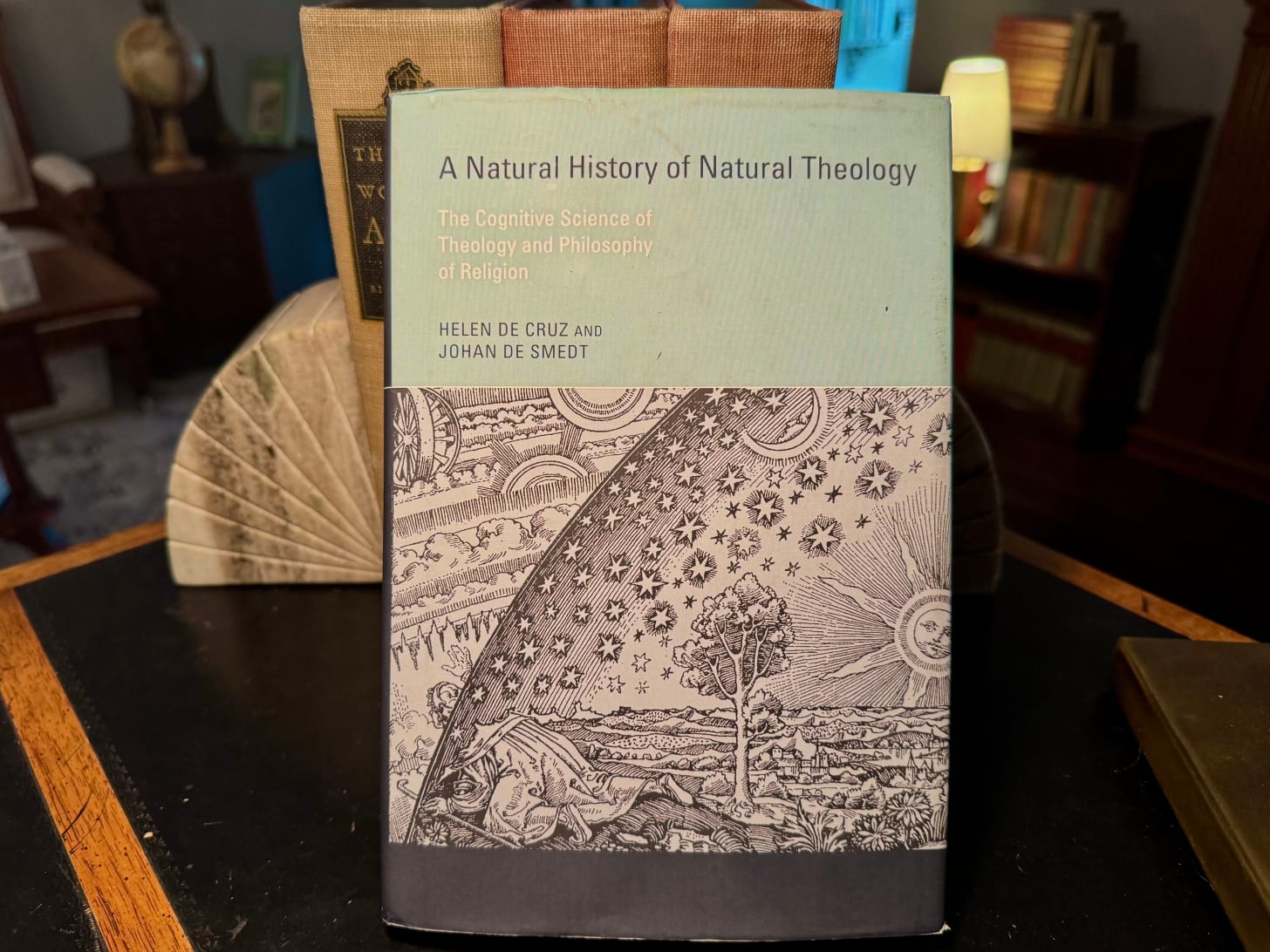Natural Selection Only Explains a Fraction of Biological Adaptation
Chance and necessity alone cannot explain the origin of biological diversity.

In A Natural History of Natural Theology, my late professor Helen De Cruz (1978-2025) and husband Johan De Smedt write that “most modern versions of the design argument do not take natural selection and its principle of cumulative selective retention into account as a viable explanation” (75).
Advocates of the design argument have not proven that the argument remains valid after Darwin; they—we—have simply ignored natural selection.
Dr. De Cruz, who served on the committee for my dissertation prospectus, died this June at the age of 46 of an aggressive illness. She left behind two children and a husband. Her work in philosophy was truly remarkable, not to mention her prior Ph.D. in art history, her fiction-writing, and lute-playing(!). While this article engages in criticism, it arises from deep respect for her amazing, cross-disciplinary scholarship.
However, while De Cruz and De Smedt argue that contemporary natural theologians ignore natural selection, their own description of natural selection is simplistic.
They illustrate the process with an example of Richard Dawkins’. And they begin with an important admission:
The likelihood that a computer program that generates random combinations of letters will produce by pure chance a phrase from Shakespeare’s Hamlet, such as METHINKSITISLIKEAWEASEL, is vanishingly small.
(I did the math; that’s less than 1 in 1032!)
But here’s how natural selection can overcome this probability threshold:
However, allowing the computer to retain the correct letters at each attempt will produce the sentence in no more than 23 × 26 = 598 runs.
Allowing the computer to retain the correct letters at each attempt?
That’s not natural selection. That’s cheating.
What I greatly respect about Dr. De Cruz’s work is its careful integration of science with philosophy and theology. For example:
But on this point, I find myself disappointed.
I had hoped for a robust analysis of wherein modern evolutionary science conflicts with the design argument. Instead, I find an inaccurate overestimate of the power of natural selection, with the assumption that natural selection is the sole causal source of biological evolution.
De Cruz and De Smedt are also dismissive toward Bill Dembski and the theory of Intelligent Design. (At least they are willing to cite Dembski!) As a result, I find myself craving more accurate analysis of the power and limits of modern evolutionary theory and the remaining viability of teleological thinking in science and philosophy.
In this article, I’ll argue that De Cruz and De Smedt’s analysis of natural selection assumes the presence of design and, citing Bill Dembski’s recent article on “the conservation of information,” argue that natural selection explains only a fraction of biological diversity.
While structural biologists, admitting the problem, propose additional mechanisms of evolution, I conclude that no naturalistic explanation of the origin of biological diversity yet exists. The design argument, therefore, remains as viable as ever.
1. Natural Selection…Plus Additional Programming

In his analysis of the origin of biological forms, Aristotle discussed three kinds of cause: Chance, Necessity, and Purpose.
(This is distinct from his “four causes” idea.)
In his contemporary defense of the design inference, Dembski discusses the same three, calling them “chance, regularity, and design.”
But De Cruz and De Smedt argue that this is to ignore a fourth causal option that modern science has turned up: Natural selection.
Admittedly, natural selection is not independent of the other three causes. It is a combination of chance and regularity, and purportedly, it mimics or creates the appearance of design.
On this analysis, Aristotle’s trichotomy has been superseded by Darwin’s tetrachotomy. Hence, contemporary teleologists, including intelligent design theorists, are working with an outdated palette of options.
For pre-Darwinians like Aristotle and Cicero, and even William Paley, “natural selection was not in the pool of possible explanations,” De Cruz and De Smedt admit. But for modern advocates “of the design argument,” De Cruz and De Smedt allege that they “do not take natural selection and its principle of cumulative selective retention into account as a viable explanation” (75). Modern advocates of design are simply ignoring the advance made by Darwin’s discovery of natural selection.
But as revealed in the above example, De Cruz and De Smedt confuse natural selection’s combination of chance and regularity with the workings of a pre-programmed filter.
While the chance of producing METHINKSITISLIKEAWEASEL by chance is prohibitively low, they argue that, by the “principle of cumulative selective retention,” a computer could reduce the odds from <1 in 1032 to something that could be produced in less than 600 attempts:
Allowing the computer to retain the correct letters at each attempt will produce the sentence in no more than 23 × 26 = 598 runs.
But a computer program that “retained the correct letters at each attempt” would not be a combination only of chance and regularity, but of chance, regularity, and design.
Chance is involved in the mechanism of random-letter-generation.
Regularity governs the mechanical working of the computer’s selection mechanism.
But allowing, i.e., programming, a “computer to retain the correct letters at each attempt” would require design.
While De Cruz and De Smedt are confident that “Darwin…came up with natural selection as a naturalistic explanation of design,” their own description of its workings—even as highly-educated, scientifically-informed philosophers over a century and a half after the publication of On the Origin of Species—tacitly invokes design.
2. Information In, Information Out

This week, mathematician and philosopher Bill Dembski shared on his Substack an academic article he published earlier this month: “The Law of Conservation of Information: Search Processes Only Redistribute Existing Information.”
In that article, Dembski argues the following:
Conservation of information sparked scientific interest once a recurring pattern was noticed in the evolutionary computing literature. In grappling with the creation of information through evolutionary algorithms, this literature consistently revealed that the information outputted by such algorithms always needed first to be programmed into them.
Thus, the primary goal of this literature—to uncover how information could be created from scratch or de novo—was shown to be misconceived: the information was not created but instead shuffled around or smuggled in, implying that it already existed in some form or other.
Information output in these situations therefore always presupposed a counterbalancing input of prior information.
In other words, mechanistic processes are incapable of producing new information. The most a mechanistic process can do is shuffle it around or destroy it.
Accordingly, while natural selection was an important scientific discovery, it does not have the power to produce new biological information (or lines of Shakespeare). It can only reshuffle or destroy existing information.
Consider an example of biological evolution for which the mechanism of natural selection is adequate: The evolution of the polar bear.
Scientists believe that the polar bear shares a common ancestor with the brown bear and the North American black bear. The evidence of this is their shared genetic material, less two notable mutations.
One mutation is to a gene
involved in fat metabolism, which allows the polar bear to have a diet that ‘contains a very large proportion of fat (much higher than in the diet of brown bears)’ (Behe, Darwin Devolves, 16). The second gene “is associated with pigmentation, and changes in it are probably responsible for the blanching of the [polar bear] ancestors’ brown fur” (17).
(I wrote about this here.)
Yet both mutations, when they occur in other mammals, are damaging.
“When the same gene is mutated in humans or mice, studies show it frequently leads to high levels of cholesterol and heart disease” (Behe, 17).
Likewise, the loss of pigmentation in the fur was a loss of functional genetic material, not the creation of a new gene for white fur.
As I once summarized it,
“Scientists have reason to believe that both variations that occurred in polar bears [involved] a loss of genetic information that, as we saw, is shared by mammals, up to and including humans.”
In other words, in a scientifically demonstrable instance where biological evolution was caused by natural selection, no new information was created. Biological information was lost. And this loss of biological information was, by accident, beneficial. It was selectively retained without any pre-programming—without any design.
Importantly, however, while natural selection can explain how the polar bear evolved from the biological kind of bear that was the common ancestral population of the brown bear and the North American black bear, it cannot explain the origin of the biological information that gave rise to that ancestral kind of bear in the first place.
Natural selection explains the survival, but not the arrival of the fittest.
Natural selection explains the speciation of an off-shoot, whose differentiating mutations are damaging to existing functional genes.
But what natural selection cannot explain is the origin of biological kinds.
3. Evolutionists, Don’t Give Up!
In What Darwin Got Wrong, philosopher Jerry Fodor and cognitive scientist Massimo Piattelli-Palmarini report that, among structural biologists, no one believes that natural selection is sufficient to explain biological diversity: “None of them is ‘that kind’ of Darwinist any more” (xiv).
However, Fodor and Piattelli-Palmarini report that this admission from structural biologists has yet to influence “informed opinion in [other] fields,” including those they have worked in, like philosophy and cognitive science (xiv). “In all of these, neo-Darwinism is taken as axiomatic; it goes literally unquestioned.”
Neo-Darwinism: Random genetic mutation and chance-based natural selection suffice to explain the origin of biological diversity.
They include an entire appendix of scholars outside of “‘wet’ biology” assuming neo-Darwinism axiomatically to demonstrate this.
They could add to their list De Cruz and De Smedt’s axiomatic assumption of neo-Darwinism (or adaptationism).
While I am disappointed by De Cruz and De Smedt’s analysis of how modern evolutionary science affects the viability of the design argument, this does not mean that evolutionary science has not affected the design argument.
In the first place, natural selection has been shown to have the power to explain variations in the color of moths, the separate, convergent evolution of sub-varieties of Cichlids (a kind of African fish) in merely thousands of years, and the evolution of the polar bear from an ancestral kind of bear.
In the second place, as Fodor and Piattelli-Palmarini describe—as well as Andreas Wagner in Arrival of the Fittest—contemporary structural and computational biologists are considering many other causal mechanisms that (may) contribute to biological evolution. Especially, they are considering non-random sources of variation from the internal structure of the organism and the possibility-space of biological forms.
Now, I don’t want to advocate a “God of the gaps” argument any more than the next guy. So bring on new mechanisms of evolution, evolutionists.
But let’s not pretend that anyone has yet demonstrated that there is a naturalistic mechanism that can produce the panoply of biological diversity and apparent design.
Because so far, the best of evolutionary science has explained only a fraction of biological adaptation.
Before You Go: Subscribe to Bill Dembski’s Substack
Oh, and why doesn’t Bill Dembski have more subscribers? (He currently has only 724.)
Go read and subscribe to his newsletter now!
Further Reading:
Why Not Theistic Evolution? Part 3: Darwinism Is Devolution
Imagine a machine that produces and reproduces video games. An internal mechanism replicates the digital code of an existing game and spits out a copy of that game. The mechanism is quite reliable, but not perfect. Every so often it will change a command or a letter of programming language.







Darwinism is so silly, it's wild we still have to even engage with it...
You are right to criticize the particular argument given by De Cruz. Natural selection only acts on present fitness, and not on potential future fitness. Half developed wings which will later allow flight are not selected for because of the fitness benefits of flight, but merely on the basis of any present benefits they may contribute to survival. Natural selection working on mutations does not seem sufficient to explain all the variety of life. However, it seems as though the conservation of information thesis is clearly false. Suppose we have a gene coding for a protein. It is quite possible for this gene to be duplicated by mutation, and then mutations can occur in the duplicated gene. Given enough random mutation, it may come about that this copy of the gene will code for slightly different proteins which may impart some selective advantage. Thus, it appears that new information has been created.
Finally, I would suggest that the inability to give an actual explanation of evolutionary change is not necessarily a huge problem for evolutionary biology. It is conceivable that no set of laws and principles will explain biological change in a satisfactory way. Newton put forward no hypothesis on the cause or nature of universal gravitation. What evolution describes is the general process by which the fossil record comes to include increasingly diverse types of organism in increasing shallow and more recent rock-layers, often showing step by step divergence in form. It is true we do not have clear evidence for the origin of major body plans (there may be transitional forms between birds and dinosaurs, but not between sponges and jellyfish), but it is reasonable in science to proceed from a more limited case to a more general application. Evolution continues to give a good idea of the sorts of things we will find in the fossil record at specific time periods, and thus fulfills its purpose. Evolutionary biology is ultimately as much a branch of history making use of biology, as it is a branch of biology, so it not surprising that, like human history, much is missing from our understanding of the causes of events in evolutionary history.
I would agree with you that intelligence and design is involved in the development of life, but this does not contradict evolutionary theory, merely the naturalistic neo-Darwinian synthesis. My own belief is that much of evolution is miraculous, and not ultimately subject to human understanding of its causes. That almost all life descends from single celled organisms is a historical fact, like the resurrection of our Lord, and thus there is evidence for it if one looks, but it is not something the causes of which are necessarily scientifically explicable. It seems impossible to me that something like eusociality could evolve in insects, and yet it did, and the similarities between social and non-social varieties of insects seem to suggest that eusocial insects are descended from non-eusocial insects. My inability to fully explain or understand this apparently miraculous development does not mean that development did not occur.